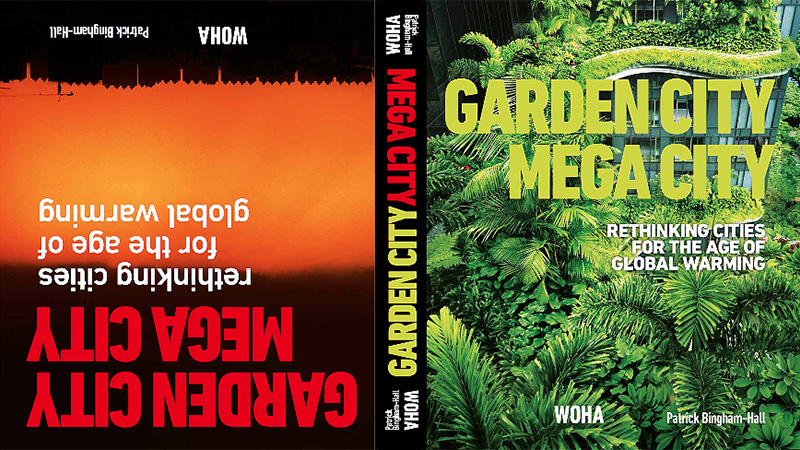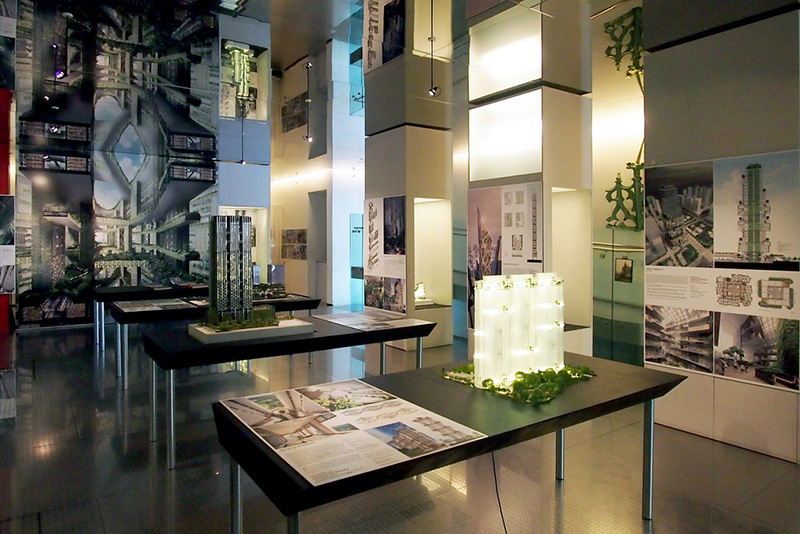Book Review: Garden City Mega City
Garden City Mega City: Rethinking Cities for the Age of Global Warming by WOHA & Patrick Bingham-Hall
Pesaro Publishing, 2016
Paperback, 384 pages

[Front and back covers of Garden City | Mega City | Image: Pesaro Publishing]
Two thousand sixteen was a good year for Singapore's WOHA: the firm had just completed Skyville@Dawson, one of their largest projects; their projects were put on display at an excellent exhibition at the Skyscraper Museum in New York City; they participated in the Venice Architecture Biennale; and they released their latest monograph, Garden City Mega City. It was at the Biennale that I first encountered the book by WOHA and longtime collaborator Patrick Bingham-Hall, the photographer, writer and head of Pesaro Publishing. A book launch took place at Palazzo Bembo, inside a darkened room whose walls were graced with drones-eye videos of their projects. Some covers of the books laid out on a table showed the lush vegetation covering their PARKROYAL on Pickering, while others showed a skyline of generic apartment blocks under an ominous orange sky. This prompted one visitor to ask if he could take both books, only to learn from WOHA's Wong Mun Summ and Richard Hassell that it was in fact one book in two halves: the 75-page Mega City, which focuses on problems; and the 309-page Garden City, which proposes solutions.

[Garden City | Mega City exhibition at the Skyscraper Museum | Photo by John Hill]
To get the most from the book, it makes sense for one to start with Mega City, in order to digest the problems that WOHA's practice tries to address. At this point in the 21st century the problems – pollution, global inequality, greenwashing, overpopulation, energy-hogging buildings, climate change, etc. – are widely known. It makes sense that these issues are not discussed in depth through lots of text; rather their is a 50/50 split between text and imagery that gets the points across. A couple important points come to the fore in this half: that most of the so-called mega cities are found in tropical, not temperate climates; and that for every vicious cycle in place (expressed in the example of Bangalore) there is a "virtuous cycle" that can reverse it (Dhaka is used as an example here). Even amongst the gloom, there is some hope.

[PARKROYAL on Pickering | Photo by John Hill]
The inverse side, Garden City, is as much manifesto as it is monograph. While certainly focused on WOHA's research, speculative proposals, and real-world commissions, their output is presented thematically, polemically, and piecemeal, rather than one project after another. Four chapters comprise the most of Garden City: Layering Cities, Planting Cities, Breathing Cities, and Rating Cities. As an illustration, within the first chapter are found five themes, the first being "multiple ground levels." After some bullet points on their benefits, instances of their use in WOHA projects are presented, including Skyville@Dawson, which is made up of 11-story "sky villages" linked by above-ground walkways.
Two chapters follow the four mentioned above: Prototypology and Self-Sufficient City. The first presents the projects that were touched upon in the earlier chapters, but it does so alongside WOHA's own five-part metric that ranks how well developments contribute to social and environmental sustainability. One could argue that LEED, Living Building Challenge, and other green building guidelines already to that, but they don't do it to the same degree nor in such terms as "civic generosity." WOHA's metrics are apparently more ambitious than other standards, yet they are still practical.

[Spread from Garden City Mega City | Image courtesy of PLANE - SITE]
These metrics point the way to the Self-Sufficient City, a master plan that incorporates the lessons outlined in the rest of the book, but done on a nearly unimaginable scale: 210,000 people on 1,800 acres of secondary rainforest in Jakarta. Although presented in renderings as 60-meter-tall buildings seamlessly blending with the forested landscape, I can only imagine an undertaking of this size destroying the forest as the project gets built – if it were built at all. Perhaps that is why I find myself more in favor of WOHA's projects in the middle of Singapore and other tropical cities. Such buildings as PARKROYAL on Pickering are a canvas for plants, in effect reintroducing vegetation into cities. With that in mind, there is plenty in Garden City Mega City to keep me – and I'm sure others – happy and full of hope.
Pesaro Publishing, 2016
Paperback, 384 pages

[Front and back covers of Garden City | Mega City | Image: Pesaro Publishing]
Two thousand sixteen was a good year for Singapore's WOHA: the firm had just completed Skyville@Dawson, one of their largest projects; their projects were put on display at an excellent exhibition at the Skyscraper Museum in New York City; they participated in the Venice Architecture Biennale; and they released their latest monograph, Garden City Mega City. It was at the Biennale that I first encountered the book by WOHA and longtime collaborator Patrick Bingham-Hall, the photographer, writer and head of Pesaro Publishing. A book launch took place at Palazzo Bembo, inside a darkened room whose walls were graced with drones-eye videos of their projects. Some covers of the books laid out on a table showed the lush vegetation covering their PARKROYAL on Pickering, while others showed a skyline of generic apartment blocks under an ominous orange sky. This prompted one visitor to ask if he could take both books, only to learn from WOHA's Wong Mun Summ and Richard Hassell that it was in fact one book in two halves: the 75-page Mega City, which focuses on problems; and the 309-page Garden City, which proposes solutions.

[Garden City | Mega City exhibition at the Skyscraper Museum | Photo by John Hill]
To get the most from the book, it makes sense for one to start with Mega City, in order to digest the problems that WOHA's practice tries to address. At this point in the 21st century the problems – pollution, global inequality, greenwashing, overpopulation, energy-hogging buildings, climate change, etc. – are widely known. It makes sense that these issues are not discussed in depth through lots of text; rather their is a 50/50 split between text and imagery that gets the points across. A couple important points come to the fore in this half: that most of the so-called mega cities are found in tropical, not temperate climates; and that for every vicious cycle in place (expressed in the example of Bangalore) there is a "virtuous cycle" that can reverse it (Dhaka is used as an example here). Even amongst the gloom, there is some hope.

[PARKROYAL on Pickering | Photo by John Hill]
The inverse side, Garden City, is as much manifesto as it is monograph. While certainly focused on WOHA's research, speculative proposals, and real-world commissions, their output is presented thematically, polemically, and piecemeal, rather than one project after another. Four chapters comprise the most of Garden City: Layering Cities, Planting Cities, Breathing Cities, and Rating Cities. As an illustration, within the first chapter are found five themes, the first being "multiple ground levels." After some bullet points on their benefits, instances of their use in WOHA projects are presented, including Skyville@Dawson, which is made up of 11-story "sky villages" linked by above-ground walkways.
Two chapters follow the four mentioned above: Prototypology and Self-Sufficient City. The first presents the projects that were touched upon in the earlier chapters, but it does so alongside WOHA's own five-part metric that ranks how well developments contribute to social and environmental sustainability. One could argue that LEED, Living Building Challenge, and other green building guidelines already to that, but they don't do it to the same degree nor in such terms as "civic generosity." WOHA's metrics are apparently more ambitious than other standards, yet they are still practical.

[Spread from Garden City Mega City | Image courtesy of PLANE - SITE]
These metrics point the way to the Self-Sufficient City, a master plan that incorporates the lessons outlined in the rest of the book, but done on a nearly unimaginable scale: 210,000 people on 1,800 acres of secondary rainforest in Jakarta. Although presented in renderings as 60-meter-tall buildings seamlessly blending with the forested landscape, I can only imagine an undertaking of this size destroying the forest as the project gets built – if it were built at all. Perhaps that is why I find myself more in favor of WOHA's projects in the middle of Singapore and other tropical cities. Such buildings as PARKROYAL on Pickering are a canvas for plants, in effect reintroducing vegetation into cities. With that in mind, there is plenty in Garden City Mega City to keep me – and I'm sure others – happy and full of hope.
Comments
Post a Comment
Comments are moderated for spam.